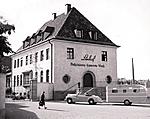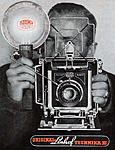How the Linhof Technika became Super…
Every Super Hero has a good origin story. Ours begins in Munich Germany in 1934. The Original Linhof Technika was born when Chief Designer Nikolaus Karpf invented a lockable articulating back for the all metal Linhof folding baseboard camera.This invention of the articulating back technical camera set Linhof apart from their competition and established them at the top of the very competitive German camera industry of the 1930’s.
Before world war II Hugo Meyer in Europe and Kalart in North America made aftermarket rangefinders for large and medium format cameras. These were limited to use on a single lens and were often added by the camera dealer at the time of camera purchase. Some manufactures like Graflex installed the Kalart rangefinder at the factory.
The Linhof factory in Munich Germany had been partially destroyed in a bombing raid near the close of WWII. Following the war Linhof Prazisions-Kamera of Munich found itself within the West German territory, controlled by the US occupation forces, and included in a broad and aggressive program of industrial and economic recovery from the devastation of the war. American camera experts from Kodak, Graflex and other top Western companies were brought in to consult and map out a recovery for the German camera industry.
One of the top suggestions from the American advisors was for Linhof to add a rangefinder to its Large Format cameras to make it competitive with the hugely popular American Speed Graphic press camera. Nikolaus Karpf was the chief designer, inventor of the Technika, Grandson-in-Law to the founder Valentin Linhof, and the owner of Linhof Prazisions-Kamera Munchen. Karpf not only liked this idea but intended to take it a step further. The Kalart and Hugo-Meyer rangefinders were limited to use with a single lens, Linhof would design a revolutionary rangefinder in house that would work with the full range of lenses designed for the camera.
The war in Germany ended on May 8, 1945. By October 1946 Linhof released the all new Technika model III in 9x12cm (4x5”). The first batch of Technika III’s were made both with and without a rangefinder. 2,021 was the first Technika III with a rangefinder, and 5,006 was the first Technika III without one. This resulted in two separate serial number lines that has caused some confusion as they are not sequential when combined.
Linhof’s rangefinder or Entfernungsmesser as it is called in German was a technical marvel. Through the use of interchangeable little butter-knife shaped quick-change cams the rangefinder was instantly calibrated to the lens. Justifiably proud of their achievement the Technika Entfernungsmesser was badged as the Technika E and aggressively marketed worldwide.
The Technika III E was a huge hit. In 1950 Linhof restyled the 4x5” Technika III and released 2 new Technika models a larger 13x18cm (5x7”) Technika III camera and in 1952 a smaller 6x9cm (2x3”) Technika 23 camera sporting a beautiful large viewfinder combined with the rangefinder. In the North American market the new Technika III E models were named Super Technika III’s. Outside North America the name remained the Technika III E.
The Super Technika moniker was adopted World Wide by Linhof during the Photokina of 1956 in Cologne Germany. The Worlds largest camera exhibition Photokina was opened that year with a greeting telegram from the US president Dwight Eisenhower. Linhof was a highlight at Photokina announcing six new cameras intended for release in conjunction with Linhof’s 70th birthday in 1957. the ambitious release included the all new Super Technika IV 4x5” and an updated 5x7” Super Technika IV & Super Technika 23. While you could still buy a non-Super model without a rangefinder few of these models were sold and they are somewhat rare today.
The 4x5 Super Technika IV was truly a completely Super camera! Evolved from the original Technika of 1934 it was a reimagining of the Technika III. Amazingly the 1956 Super Technika IV design has lasted nearly 65 years and into the present day! The models that followed, the Super Technika V and Master Technika have only added incremental refinements building upon and perfecting the original design of the Super Technika IV.
The 6x9 and 5x7 models of 1956 were more of a model refresh rather than a complete redesign. The 5x7 would be redesigned into its final design in 1963 as the Super Technika V. The 6x9 Super Technika would go through several redesigns over the 40 years Linhof made it.
To ensure the Super status of their beloved hand crafted cameras Linhof contracted the top German optics companies to make special lenses to complete the Super camera. Some of the most iconic LF lenses ever made resulted. The Schneider 150mm 2.8 Xenotar, Voigtlander 150 & 210mm APO Lanthar, and the Zeiss 75mm Biogon, 135mm Planar, & 250mm Sonnar were all designed specifically for the Super Technika.
This was the Golden Age for Linhof and the Super Technika title would stand to define the top of the line in professional and high end amateur cameras for the next 60 years…
The Super Technika 4x5” became an updated Super Technika V in 1963 and the updated version in 1972 was renamed the Master Technika. The Master Technika 4x5” is still made by Linhof today. It is available with or without the Entfernungsmesser.
The Super Technika 5x7” became the Super Technika V in 1964 and was refreshed in 1979 into the Super Technika V-B. The Super Technika V-B was made until 1986.
The Super Technika 23 was replaced in 1963 with an all new design the Technika 70. Although it did not carry the Super label it was a special camera, the very large combined viewfinder with rangefinder atop the Technika 70 represents the highest level Linhof, or likely anyone else, ever achieved in mechanical rangefinder technology. The Technika 70 also won several prestigious design awards for its appearance. In 1970 the Technika 70 was re-designed. The large viewfinder was removed and the rangefinder was changed to the same style side mounted rangefinder as the 4x5” cameras, This new design was named the Super Technika V. This would be the last of the Linhof Supers and was made at the Linhof factory in Munich until 1990.
The 4x5 Linhof rangefinder evolution over 80 years.
4x5” RF Housing - The very first rangefinder housing of 1946 was square like the Hugo-Meyer with round windows like the Kal-Art. The square housing sat in the middle on the right side between the lock knobs for the rear standard. A little over a year later and the angled shape we know today emerged. In 1950 the Technika III styling was refreshed, the Lock Knobs for the rear standard were moved to the top of the camera and the rangefinder moved up to be flush with the top just like it is today. The 1956 IV included a port on top for a Kal-Art focus spot and in 1960 the IV was refreshed and the hawksbill shape that we have today was added for extra flash handle security.
4x5” RF Cams - The cams have evolved over time as well. The early Technika III E cams 1947-1949 are different than the Super Technika III 1950-1957. The early cams are wider and stubbier than the butterknife like cams of 1950 onward. The early cams are double sided with 150mm and 90mm and the base where they plug in is wider than the later style. As such they are too wide to fit into a 1950 or later model and the later style are too narrow to attach to the early model. The cam changed for the final time with the IV of 1957, once again they do not fit in or accept earlier types. All III and IV cams are lens and camera specific. When the lens is calibrated to the cameras rangefinder both the serial number of the camera and the lens is engraved into the cam, and precise focus is only assured if a matched cam for a particular body and lens are used. From the Technika V up through todays Master Technika the cams only need be calibrated to the lens and only the lens serial number is engraved onto the cam. This allows lens and matched cam to be used interchangeably on all Super Technika V and Master cameras. Just exactly what Linhof did between the IV and V to zero the ground glass and allow for greater cam interchangeability is unknown to me. If I find out I will share this information.
Although the large beautiful viewfinder with rangefinder of the Technika 70 is the height of Linhof’s mechanical accomplishment, the peak of Linhof’s Entfernungsmesser achievement happened In 1995. It was the first ever Large Format Electronic Viewfinder and Rangefinder, available as an accessory attachment for the 4x5” Master Technika 2000. “Precision Engineering met Advanced Electronics” and Linhof created the “Large Format System of the Future” - The EMS (I was hoping for some really long German words to make up this acronym, maybe Entfernungsmesser-Messsystem Sucherbut… as yet I haven't found it…. Unfortunately it might be the rather pedestrian English: Electronic Measuring System). It generated very high praise and excitement when it first arrived but perhaps it was ahead of its time. The EMS unit was expensive and not foolproof, especially with longer focal lengths. Sales were low and eventually rather than trying to maintain the project Linhof offered to buy them back. Most were returned to Linhof but a handful remain in the wild today.






 Reply With Quote
Reply With Quote

Bookmarks